New big prop, facing the A320 & 737: TurboLiner.
Thread Starter
Join Date: Oct 2007
Location: netherlands
Age: 56
Posts: 769
Likes: 0
Received 0 Likes
on
0 Posts
New big prop, facing the A320 & 737: TurboLiner.
Both Airbus and Boeing are comfortably sitting on their narrowbody duopoly and enjoying a huge narrowbody backlog.
No wonder both say a 737 / A320 replacement is "unfeasible" & they suggest "end of next decade".
I donīt think so. Turboprops are 20% more fuel efficient then comparable turbofans and other technologies have evolved.
Both 737 and A320 and made to do flights up to 3000nm while most are under 1000nm in e.g. Europe.
Time to start up powerpoint & draw some lines.

As you can see I integrated electric Wheeltug like drives in the main landing gear. This will enable the aircraft to "pushback" and taxi to / from the runway on its own (APU) power. Saving fuel and noise.
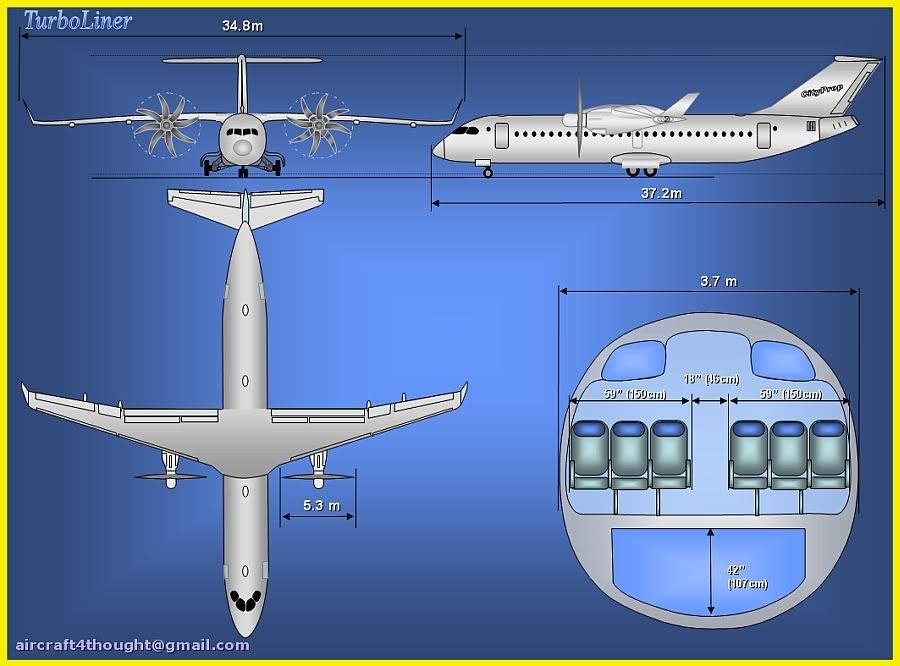
The fuselage is a few inch wider then a BAE146 but has a different shape. 6 abreast is acceptable because of short trips I think. It is optimized for about 150 seats.
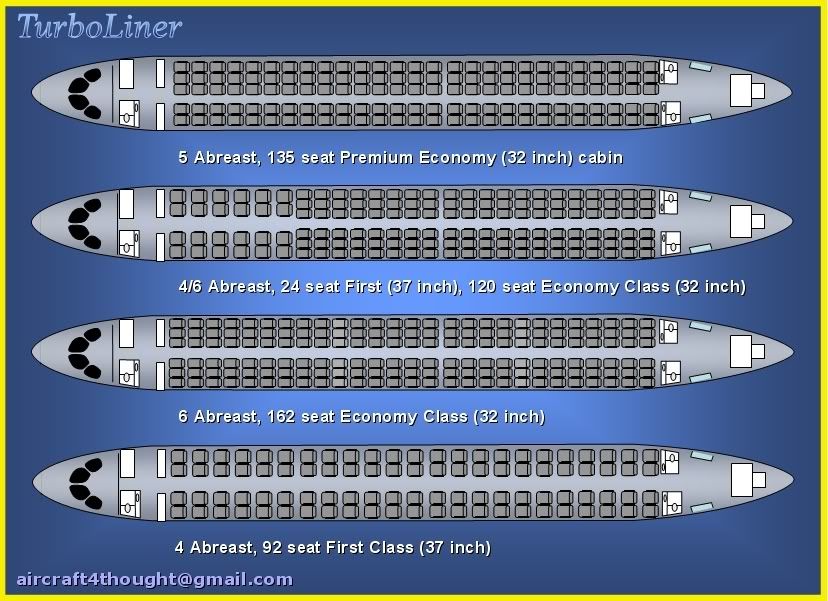
I have some more graphics. What do you think of the concept?
No wonder both say a 737 / A320 replacement is "unfeasible" & they suggest "end of next decade".
I donīt think so. Turboprops are 20% more fuel efficient then comparable turbofans and other technologies have evolved.
Both 737 and A320 and made to do flights up to 3000nm while most are under 1000nm in e.g. Europe.
Time to start up powerpoint & draw some lines.

As you can see I integrated electric Wheeltug like drives in the main landing gear. This will enable the aircraft to "pushback" and taxi to / from the runway on its own (APU) power. Saving fuel and noise.

The fuselage is a few inch wider then a BAE146 but has a different shape. 6 abreast is acceptable because of short trips I think. It is optimized for about 150 seats.

I have some more graphics. What do you think of the concept?
Last edited by keesje; 24th Mar 2008 at 13:29. Reason: spelling
Join Date: Mar 2000
Location: Arizona USA
Posts: 8,571
Likes: 0
Received 0 Likes
on
0 Posts
It'll never be accepted by the fare paying customer, aka, the passenger.
And further, having flown quite large piston and especially turbopropellor aircraft in the past, and further remembering the eleven (IIRC) pitch locks on each Electra AeroProducts propellor...big propellors present ever-bigger problems.
Bad idea, that is never likely to see the light of day.
And further, having flown quite large piston and especially turbopropellor aircraft in the past, and further remembering the eleven (IIRC) pitch locks on each Electra AeroProducts propellor...big propellors present ever-bigger problems.
Bad idea, that is never likely to see the light of day.
It's got some merits, but there are lots of detractors as well.
It's a turboprop. Passengers don't like turboprops (as 411 has said) which is one reason why you see more regional jets around these days. Also, turboprops need a lot of maintenance. propellers are very costly to maintain and one of the main reasons a turboprop gets stuck on the ground with tech problems.
Turboprops fly slower than jets. It will get stuck at lower levels to keep it out of the way making it slower and more costly to run. the RAF found this with their new C130s. Although it had the ability to fly higher than the older C130s, it just isn't usually allowed to climb to jet levels.
At highest density seating, it's only really a competitor to the A319 and shorter B737s. This will limit the market.
Built in powerpushes have been looked at before. The weight penalty doesn't make them attractive. besides, if it's a turboprop - why not give it the ability to reverse using the engines?
Rooftop windows? Why? It's just another hole in the pressure hull and will add to the cost.
I would see it would have a future in developing markets with poor infrastructure - turboprops have better short field performance. But in Europe or the US, it's probably not going to make an impact.
It's a turboprop. Passengers don't like turboprops (as 411 has said) which is one reason why you see more regional jets around these days. Also, turboprops need a lot of maintenance. propellers are very costly to maintain and one of the main reasons a turboprop gets stuck on the ground with tech problems.
Turboprops fly slower than jets. It will get stuck at lower levels to keep it out of the way making it slower and more costly to run. the RAF found this with their new C130s. Although it had the ability to fly higher than the older C130s, it just isn't usually allowed to climb to jet levels.
At highest density seating, it's only really a competitor to the A319 and shorter B737s. This will limit the market.
Built in powerpushes have been looked at before. The weight penalty doesn't make them attractive. besides, if it's a turboprop - why not give it the ability to reverse using the engines?
Rooftop windows? Why? It's just another hole in the pressure hull and will add to the cost.
I would see it would have a future in developing markets with poor infrastructure - turboprops have better short field performance. But in Europe or the US, it's probably not going to make an impact.
Thread Starter
Join Date: Oct 2007
Location: netherlands
Age: 56
Posts: 769
Likes: 0
Received 0 Likes
on
0 Posts
Thnx for responding!
It seems passenger comfort is moving down the priority list and fuel efficiency & airport restrictions are up.
http://www.wtopnews.com/?nid=111&sid=1370946
The Turboliner is inbetween the A319 and A320 and 737 and 738. A huge market.

I took the A320/737 window arrangement as a starting point and removed 20% / 12 windows and places 4 rooftop windows.  I think natural light in the cabin could improve cabin admosphere / space perception while reducing weight.
I think natural light in the cabin could improve cabin admosphere / space perception while reducing weight.
I flew from LCY last week. Apart from BAE 146, props were the dominant aircraft; F50s, ATR, Saabs and Q400s flying under flags of airlines like SAS, KLM, LH, BA Swiss, AF. I have the impression pax were fare paying, or at least their bosses.  http://www.youtube.com/watch?v=hY5TueMRq0k
http://www.youtube.com/watch?v=hY5TueMRq0k
I think for medium ranges the props miss speed (although new props are speedier) and capasity / ceiling. However there are many areas in the world where the majority of flights is under 700 nm and cargo unimportant. Western Europe isnīt the only place. Heavy 737/A320 are "mis-used" there. Look at the route structures of the low cost airlines.
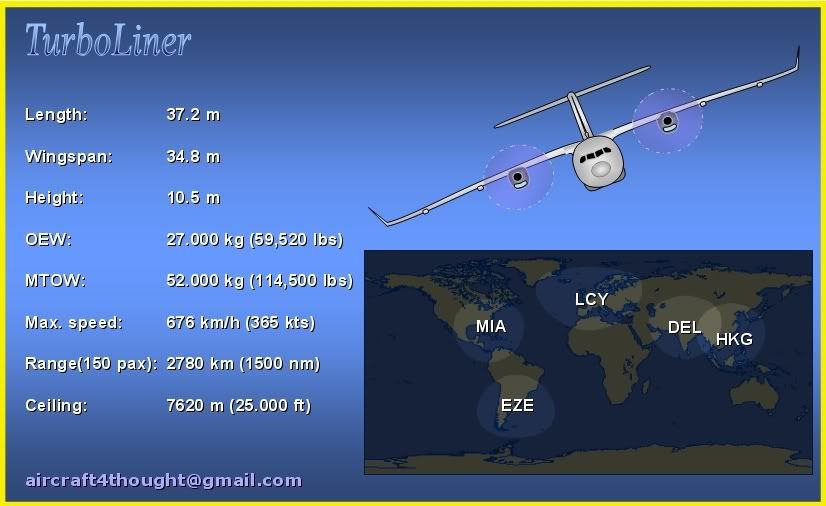
In history engine developments played a major role shaping aircraft / route structures. I think the TP400 offering power / efficiency never available in the West, combined with skyrocketing fuel prices might lead to new configurations. http://www.youtube.com/watch?v=h-V5jzSslZo
It'll never be accepted by the fare paying customer, aka, the passenger.
And further, having flown quite large piston and especially turbopropellor aircraft in the past, and further remembering the eleven (IIRC) pitch locks on each Electra AeroProducts propellor...big propellors present ever-bigger problems.
Bad idea, that is never likely to see the light of day.
And further, having flown quite large piston and especially turbopropellor aircraft in the past, and further remembering the eleven (IIRC) pitch locks on each Electra AeroProducts propellor...big propellors present ever-bigger problems.
Bad idea, that is never likely to see the light of day.
Although the latest generation of turboprops has addressed some of the comfort issues by flying above turbulence and providing quieter cabins, analysts say the airlines' money worries about their bottom line now outweigh any passenger preferences.
With jet fuel prices 60 percent to 70 percent higher than a year ago, regional jets no longer offer good economics for short-haul flights, said Michael Dyment, an aviation analyst at Nexa Capital Partners, a Washington, D.C., corporate finance group.
"Nowadays, operating efficiency trumps any passenger considerations," Dyment said.
The world's remaining manufacturers of turboprops for commuter airlines, Canada's Bombardier and France's ATR, have ramped up production to 140 of the planes this year, after making 100 deliveries in 2007. This compares with only 26 in 2002.
With jet fuel prices 60 percent to 70 percent higher than a year ago, regional jets no longer offer good economics for short-haul flights, said Michael Dyment, an aviation analyst at Nexa Capital Partners, a Washington, D.C., corporate finance group.
"Nowadays, operating efficiency trumps any passenger considerations," Dyment said.
The world's remaining manufacturers of turboprops for commuter airlines, Canada's Bombardier and France's ATR, have ramped up production to 140 of the planes this year, after making 100 deliveries in 2007. This compares with only 26 in 2002.
http://www.wtopnews.com/?nid=111&sid=1370946
At highest density seating, it's only really a competitor to the A319 and shorter B737s. This will limit the market.

Rooftop windows? Why? It's just another hole in the pressure hull and will add to the cost.
 I think natural light in the cabin could improve cabin admosphere / space perception while reducing weight.
I think natural light in the cabin could improve cabin admosphere / space perception while reducing weight.
It'll never be accepted by the fare paying customer, aka, the passenger.
 http://www.youtube.com/watch?v=hY5TueMRq0k
http://www.youtube.com/watch?v=hY5TueMRq0kI think for medium ranges the props miss speed (although new props are speedier) and capasity / ceiling. However there are many areas in the world where the majority of flights is under 700 nm and cargo unimportant. Western Europe isnīt the only place. Heavy 737/A320 are "mis-used" there. Look at the route structures of the low cost airlines.

In history engine developments played a major role shaping aircraft / route structures. I think the TP400 offering power / efficiency never available in the West, combined with skyrocketing fuel prices might lead to new configurations. http://www.youtube.com/watch?v=h-V5jzSslZo
Last edited by keesje; 28th Mar 2008 at 10:18. Reason: spelling
Join Date: Aug 2005
Location: Estonia
Posts: 834
Likes: 0
Received 0 Likes
on
0 Posts
Remember: a new big turboprop is not competing with A320/B737 (which are not replaced till 2020). It is competing against C-series geared turbofans.
As for speed - why 676 km/h? I think A400 is faster (slightly). Tu-114 is fast, too.
If you start the design of, say, ATR102 from two big turboprops of Ai-400 (with counterrotating props) - what would be your suitable MTOW?
As for skylights, remember that Tu-134 has the skylight in a toilet...
As for speed - why 676 km/h? I think A400 is faster (slightly). Tu-114 is fast, too.
If you start the design of, say, ATR102 from two big turboprops of Ai-400 (with counterrotating props) - what would be your suitable MTOW?
As for skylights, remember that Tu-134 has the skylight in a toilet...
Thread Starter
Join Date: Oct 2007
Location: netherlands
Age: 56
Posts: 769
Likes: 0
Received 0 Likes
on
0 Posts
Remember: a new big turboprop is not competing with A320/B737 (which are not replaced till 2020). It is competing against C-series geared turbofans.
As for speed - why 676 km/h? I think A400 is faster (slightly). Tu-114 is fast, too.
If you start the design of, say, ATR102 from two big turboprops of Ai-400 (with counterrotating props) - what would be your suitable MTOW?
Tu-134 has the skylight in a toilet...
 Is that so ? Anyone a picture of that? I remember the P3C had them, but obviously not only for fun / admosphere..
Is that so ? Anyone a picture of that? I remember the P3C had them, but obviously not only for fun / admosphere..
Built in powerpushes have been looked at before. The weight penalty doesn't make them attractive. besides, if it's a turboprop - why not give it the ability to reverse using the engines?
Lets remember moving around airports on engine power / with help of tugs is not for free at all.
Noise, polution and fuel consumption (weight) during airfield operations are high & airlines are looking for solutions / improvements. Imagine how quiet gates / taxiways could become. Maybe more flights at difficult hours would become allowable / feasible.
Short haul operations can include up to 14 airport movements a day per aircraft. Air Pollution is starting to limit growth in many places.
Join Date: Jan 2008
Location: UK
Posts: 12
Likes: 0
Received 0 Likes
on
0 Posts
Could GRP and Carbon Fibre be introduced to parts of the airframe to reduce weight? Flying controls, for example?
Is this feasible at these speeds? I think the Harrier makes use of composites, so it must be, I guess?
Is this feasible at these speeds? I think the Harrier makes use of composites, so it must be, I guess?
Join Date: Nov 2007
Location: Seoul
Posts: 105
Likes: 0
Received 0 Likes
on
0 Posts
From SLF
I live is Seoul and noticed that your range out of Hong Kong would reach Seoul. That got me thinking....
I have been flying around Asia for 12 years for work. Seeing a 737/320 is much less common at most airports compared to back home. I went to Vancouver last month and took a turbo prop to Kelona. Ohh what a cute little plane, and Vancouver had so many small planes (737/320s) sitting around and coming and going - neat!!
Small planes might work in the other markets you noted, but due to population dencity and oceans, which mean driving is less an option, bigger planes are relativly easy to fill even on shorter runs.
Out of about 30 flights in and out of Hong Kong, I have only flown 330s, 747s, and 777s to my recolection. The plane you suggest might work within China, say Xian to Nanjing, or in Thailand from Bangkok to Changmai, or from HK to small Chinese cities, but not much else.
However, it looks cool and I would love to fly it as a SLF. So, thanks for the idea. Your drawings are always quite interesting.
TM
I have been flying around Asia for 12 years for work. Seeing a 737/320 is much less common at most airports compared to back home. I went to Vancouver last month and took a turbo prop to Kelona. Ohh what a cute little plane, and Vancouver had so many small planes (737/320s) sitting around and coming and going - neat!!
Small planes might work in the other markets you noted, but due to population dencity and oceans, which mean driving is less an option, bigger planes are relativly easy to fill even on shorter runs.
Out of about 30 flights in and out of Hong Kong, I have only flown 330s, 747s, and 777s to my recolection. The plane you suggest might work within China, say Xian to Nanjing, or in Thailand from Bangkok to Changmai, or from HK to small Chinese cities, but not much else.
However, it looks cool and I would love to fly it as a SLF. So, thanks for the idea. Your drawings are always quite interesting.
TM
Thread Starter
Join Date: Oct 2007
Location: netherlands
Age: 56
Posts: 769
Likes: 0
Received 0 Likes
on
0 Posts
Could GRP and Carbon Fibre be introduced to parts of the airframe to reduce weight? Flying controls, for example?
Is this feasible at these speeds?
Is this feasible at these speeds?
Small planes might work in the other markets you noted, but due to population dencity and oceans, which mean driving is less an option, bigger planes are relativly easy to fill even on shorter runs.
I projected a person to show how large it is compared to existing props. It is a A319 /737-700 sized 150 seat aircraft.
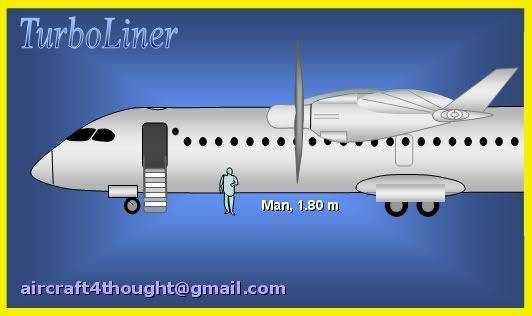
Out of about 30 flights in and out of Hong Kong, I have only flown 330s, 747s, and 777s to my recolection. The plane you suggest might work within China, say Xian to Nanjing, or in Thailand from Bangkok to Changmai, or from HK to small Chinese cities, but not much else.
Hong Kong to Seoul is best served by a 747 or an A380. Max capacity counts on this high density route. And flying turboprops out of HK won't make you popular with anyone. Everyone needs to be doing at least 300 knots. It's pretty busy!
Join Date: Aug 2005
Location: Estonia
Posts: 834
Likes: 0
Received 0 Likes
on
0 Posts
Hi chornedsnorkack. I think a fast 150 seater for regional services is A320/737 territory. I think the C-series is a bit smaller and probably longer range. Not a typical short haul people mover.
So, C150 could be an option.
Is that so ? Anyone a picture of that? I remember the P3C had them, but obviously not only for fun / admosphere..
http://www.pixel-area.com/Demo/Bluep...20TU%20134.jpg
In the tail, above the engines.
Hong Kong to Seoul is best served by a 747 or an A380. Max capacity counts on this high density route.
Thread Starter
Join Date: Oct 2007
Location: netherlands
Age: 56
Posts: 769
Likes: 0
Received 0 Likes
on
0 Posts
With props of that diameter I can see there being problems with tip speeds unless they are turning very slowly.
Over 1000 ground hours have been done on the TP400-D6. The delayed first flight on a Marshall C-130 will take place soon (hopefully) after ground runs / tests.
Could a friendly moderator shift this to spotter's corner please?
Last edited by keesje; 24th Mar 2008 at 22:29.
Join Date: Aug 2002
Location: Switzerland, Singapore
Posts: 1,309
Received 0 Likes
on
0 Posts
We don't need research in airframes if it's a propulsion problem. First we have to get the unducted fan techology, then we can go on with delopping the aircraft.
So far, unducted fan didn't work, and there wasn't enough positive feelings from the customers.
But, there are promising projects in the pipeline. So let's wait and see.
Dani
So far, unducted fan didn't work, and there wasn't enough positive feelings from the customers.
But, there are promising projects in the pipeline. So let's wait and see.
Dani
Thread Starter
Join Date: Oct 2007
Location: netherlands
Age: 56
Posts: 769
Likes: 0
Received 0 Likes
on
0 Posts
We don't need research in airframes if it's a propulsion problem. First we have to get the unducted fan techology, then we can go on with delopping the aircraft. So far, unducted fan didn't work, and there wasn't enough positive feelings from the customers. But, there are promising projects in the pipeline. So let's wait and see.
Dani this is not an unducted fan. The TP400 engine has been under development by Rolls Royce, Snecma, MTU and ITP for years. It was run first in 06 and will take to the skies in a few months. First 4 engines for the A400 prototype have been delivered earlier this year. It is not proven in service yet, but it isnīt a concept either.
In this case an the engine is there, it will enter service on the quad A400M transport aircraft. The Turboliner would use 2 TP400s.
C130 has maximum seat capacity of 145 at 5 abreast, MTOW up to 63 tons or so - bigger than A318, and closer to A319. The 64 ton version has 5000 km range - there is a version with 3300 km range and a lower MTOW.
So, C150 could be an option.
So, C150 could be an option.
The 737 / A320 weighs empty about 40 tonnes. The Turboliner would weigh under 30 tonnes. Those 10 tonnes equal 100 passengers..
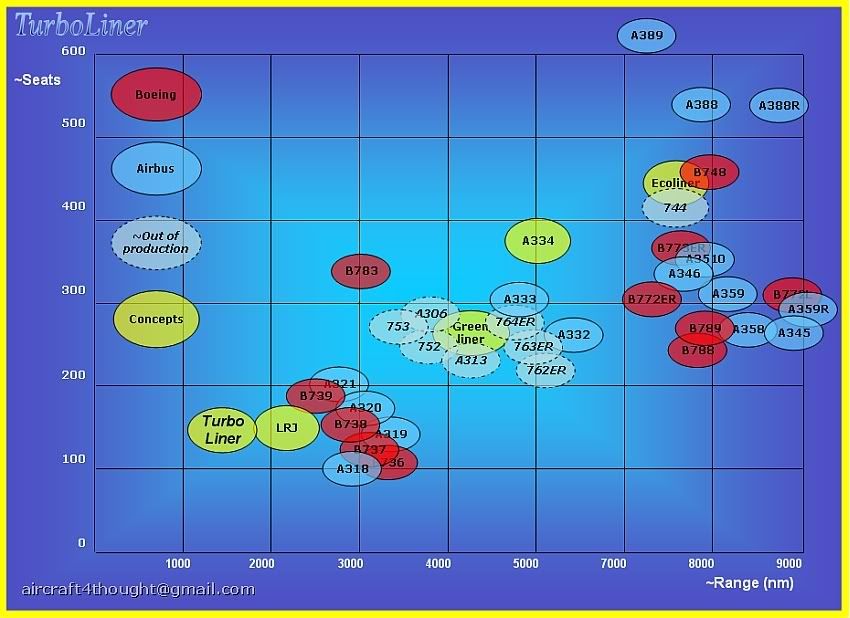
Quote:
Hong Kong to Seoul is best served by a 747 or an A380. Max capacity counts on this high density route.
Reply:
747, with the exception of 747SR models, is too much of a plane for the range. Ditto about A380-800. Cathay Pacific said that they will buy A380 if Airbus increases MTOW OR stretches the plane. So, CX could use an Airbus 380-900SR in addition to their B777-300 non-ER...
747s are used frequently on the HK Seoul route along with Manilla, Taipei and several other short range high density routes in Asia. What counts is lots of seats. JAL use the 747-400D between Tokyo and Osaka. 600 seats, no galleys, 40 minute sectors.
Now a passenger A400 with 500 seats on two decks might work!
Hong Kong to Seoul is best served by a 747 or an A380. Max capacity counts on this high density route.
Reply:
747, with the exception of 747SR models, is too much of a plane for the range. Ditto about A380-800. Cathay Pacific said that they will buy A380 if Airbus increases MTOW OR stretches the plane. So, CX could use an Airbus 380-900SR in addition to their B777-300 non-ER...
747s are used frequently on the HK Seoul route along with Manilla, Taipei and several other short range high density routes in Asia. What counts is lots of seats. JAL use the 747-400D between Tokyo and Osaka. 600 seats, no galleys, 40 minute sectors.
Now a passenger A400 with 500 seats on two decks might work!
Join Date: Aug 2005
Location: Estonia
Posts: 834
Likes: 0
Received 0 Likes
on
0 Posts
JAL use the 747-400D between Tokyo and Osaka. 600 seats, no galleys, 40 minute sectors.
I think the largest seat count Iīve heard of was 594, in Japan, and I understand it no longer flies. Currently the biggest plane in the world is the 747-400 of Corsair - with 587 seats. And they have long sectors (what about galleys?).
Oh, and technically propeller planes should be easier to stretch than jets. Low cruise Mach should allow thick, unswept wings, which would offer better resistance to bending and twisting at less structural mass. How would a Brabazon wing compare to an A380 wing?
Thread Starter
Join Date: Oct 2007
Location: netherlands
Age: 56
Posts: 769
Likes: 0
Received 0 Likes
on
0 Posts
For illustration, compared to existing props the Turboliner is longer wider and faster. Compared to A320 series smaller and lighter. It lacks the container / palet capability of the A320 family and its roomy cabin.
I think together with its semi rectangular fuselage the Turboliner offers just enough width to allow acceptable comfort & stowage for sizeable hand luggage for short haul flights.
The A319s have a wider cabin & belly haul and are able to carry 150 passengers and a healthy cargo load to level 40 quickly, go Mach 0.8, fly over the weather and put everything down 5 hours / 2500nm later. A different requirements but you pay the weight on short passenger operations like e.g. Low Cost Carriers.
Current regional props are better for ground operations, short runways, steep approaches and low fuel consumption but lack speed, climb and capasity.
I think the TurboLiner could combine capasity, fuel efficiency & airfield performance in a noise restricted environment.
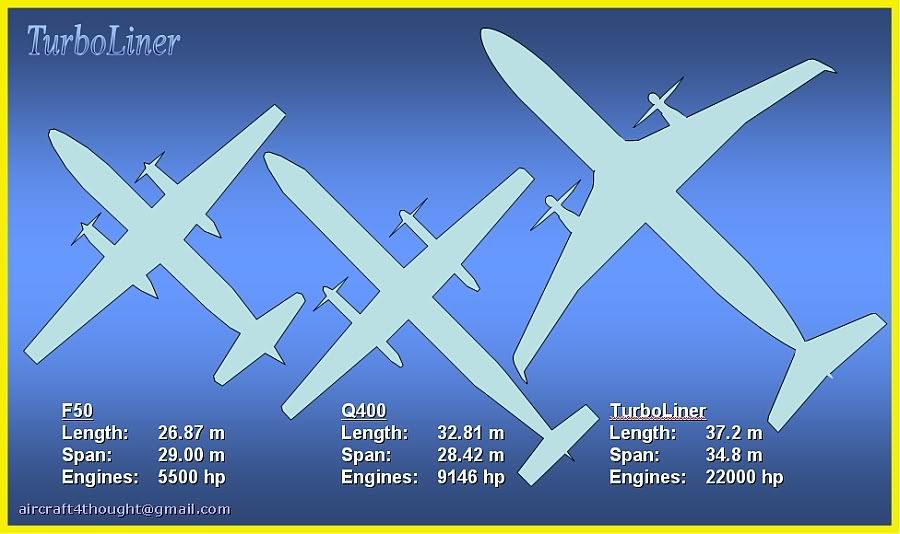
-> Anyone know what ATR, Europrop and worn BAE146 operators are thinking about the future?
-> I have seen figures on airport environmental pollution by ground moving / waiting aircraft somewhere, does anybody know where to find this info?
I think together with its semi rectangular fuselage the Turboliner offers just enough width to allow acceptable comfort & stowage for sizeable hand luggage for short haul flights.
The A319s have a wider cabin & belly haul and are able to carry 150 passengers and a healthy cargo load to level 40 quickly, go Mach 0.8, fly over the weather and put everything down 5 hours / 2500nm later. A different requirements but you pay the weight on short passenger operations like e.g. Low Cost Carriers.
Current regional props are better for ground operations, short runways, steep approaches and low fuel consumption but lack speed, climb and capasity.
I think the TurboLiner could combine capasity, fuel efficiency & airfield performance in a noise restricted environment.

-> Anyone know what ATR, Europrop and worn BAE146 operators are thinking about the future?
-> I have seen figures on airport environmental pollution by ground moving / waiting aircraft somewhere, does anybody know where to find this info?
Seems to me that what Airbus reallt need is something to fit in between the A321 and the A330-200. At the moment there is a big range/payload gap which we are having to fill with two leased 757's. A310 is now out of production and there seems to be no replacement planned.



